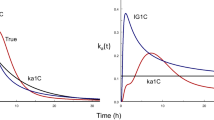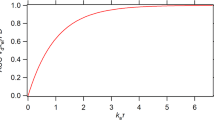Abstract
Purpose. The goals were to evaluate the usefulness of Cmax/AUClqc, ratio of the maximum plasma drug concentration to the area under the plasma concentration-time curve to the time of the last quantifiable concentration, in bioequivalence testing and to explore the use of exposure as a replacement for the concepts of rate and extent of drug absorption.
Methods. The bioequivalence of products differing in both rate (ka) and extent (F) of absorption was assessed under conditions similar to those encountered in a typical trial. A one-compartment model drug with first-order absorption (rate constant = ka) and elimination was used. Variability was introduced in all model parameters using Monte Carlo techniques. The results were expressed in terms of the probability of declaring bioequivalence in a cross-over trial with 24 subjects using Cmax/AUClqc, AUClqc, and Cmax as bioequivalence measures.
Results. The outcome of a bioequivalence trial was shown to depend on the measure. Cmax/AUClqc reflected changes in ka, but not in F. AUClqc showed dependence on F, but virtually no dependence on ka. For Cmax, a 3- to 4-fold increase in ka and a concomittant 20% decrease in F, as well as corresponding changes in the opposite directions, resulted in bioequivalent outcomes.
Conclusions. It was concluded that use of Cmax/AUClqc should be discouraged and that defining bioequivalence in terms of rate and extent of absorption has major problems. The goal of bioequivalence trials should be to assure that the shape of the concentration-time curve of the test product is sufficiently similar to that of the reference product. To this end, the use of “exposure” rather than “rate and extent of absorption” concepts is encouraged.
Similar content being viewed by others
REFERENCES
L. Aarons. Assessment of rate of absorption in bioequivalence studies. J. Pharm. Sci. 76:853–855 (1987).
F. Y. Bois, T. N. Tozer, W. W. Hauck, M.-L. Chen, R. Patnaik, and R. L. Williams. Bioequivalence: performance of several measures of extent of absorption. Pharm. Res. 11:715–722 (1994).
K. K. Midha, J. W. Hubbard, M. Rawson, and L. Gavalas. The application of partial areas in assessment of rate and extent of absorption in bioequivalence studies of conventional release products: experimental evidence. Eur. J. Pharm. Sci. 2:351–363 (1994).
F. Y. Bois, T. N. Tozer, W. W. Hauck, M.-L. Chen, R. Patnaik, and R. L. Williams. Bioequivalence: performance of several measures of rate of absorption. Pharm. Res. 11:966–974 (1994).
L. Endrenyi and W. Yan. Variation of Cmax and Cmax/AUC in investigations of bioequivalence. Int. J. Clin. Pharmacol. Ther. Toxicol. 31:184–189 (1993).
L. F. Lacey, O. N. Keene, C. Duquesnoy, and A. Bye. Evaluation of different indirect measures of rate of drug absorption in comparative pharmacokinetic studies. J. Pharm. Sci. 83:212–215 (1994).
L. Endrenyi, S. Fritsch, and W. Yan. Cmax/AUC is a clearer measure than Cmax for absorption rates in investigations of bioequivalence. Int. J. Clin. Pharmacol. Ther. Toxicol. 29:394–399 (1991).
R. Schall and H. E. Luus. Comparison of absorption rates in bioequivalence studies of immediate release drug formulations. Int. J. Clin. Pharmacol. Ther. Toxicol. 30:153–159 (1992).
C. Reppas, L. F. Lacey, O. N. Keene, P. Macheras, and A. Bye. Evaluation of different metrics as indirect measures of rate of drug absorption from extended release dosage forms at steadystate. Pharm. Res. 12(1):103–107 (1995).
M.-L. Chen. An alternative approach for assessment of rate of absorption in bioequivalence studies. Pharm. Res. 9:1380–1385 (1992).
L. Tothfalusi and L. Endrenyi. Without extrapolation, Cmax/AUC is an effective metric in investigations of bioequivalence. Pharm. Res. 12:937–942 (1995).
A. Rostami-Hodjegan, P. R. Jackson, and G. T. Tucker. Sensitivity of indirect metrics for assessing “rate” in bioequivalence studies—Moving the “goalposts” or changing the “game”. J. Pharm. Sci. 83:1554–1557 (1994).
D. J. Schuirmann. A comparison of the two one-sided tests procedure and the power approach for assessing the equivalence of average bioavailability. J. Pharmacokin. Biopharm. 15:657–580 (1987).
V. W. Steinijans, R. Sauter, D. Hauschke, E. Diletti, R. Schall, H. G. Luus, M. Elze, H. Blume, C. Hoffman, G. Franke, and W. Siegmund. Reference to tables for the intrasubject coefficient of variation in bioequivalence studies. Int. J. Clin. Pharmacol. Therap. 33:427–430 (1995).
Conduct and analysis of bioavailability and bioequivalence studies. Drug Directorate Guidelines, Canadian Health Protection Branch, 1994.
Author information
Authors and Affiliations
Rights and permissions
About this article
Cite this article
Tozer, T.N., Bois, F.Y., Hauck, W.W. et al. Absorption Rate Vs. Exposure: Which Is More Useful for Bioequivalence Testing?. Pharm Res 13, 453–456 (1996). https://doi.org/10.1023/A:1016061013606
Issue Date:
DOI: https://doi.org/10.1023/A:1016061013606




